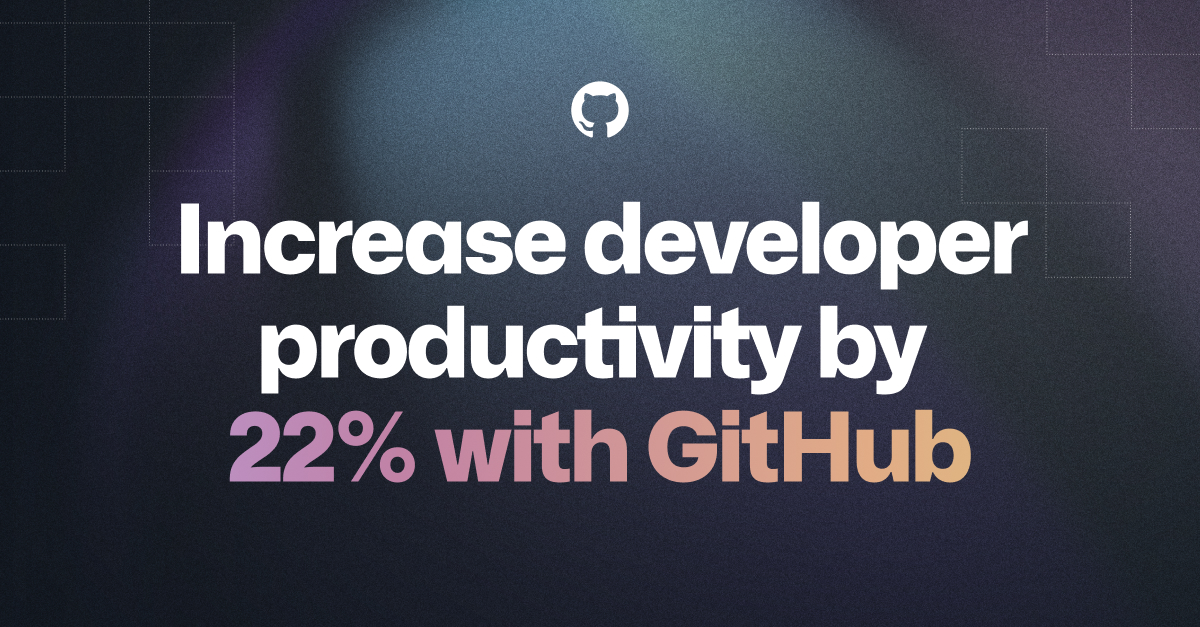Interested in reading the study and driving ROI for your enterprise? Download it today.
Increase developer productivity, save time on developer onboarding, and drive ROI in 2023
Forrester’s Total Economic Impact™ study dives into how GitHub Enterprise Cloud and GitHub Advanced Security help businesses drive ROI, increase developer productivity, and save time on developer onboarding.

What if you could remove days from your onboarding process and have developers up and running in minutes? Or save developers hours per week with more automation? How much work could your developers get done if they spent less time switching between different tools and tasks? And what if reducing the amount of tools also reduced your operational costs?
These are common struggles developer teams face and were some of the challenges Canadian communications and IT provider TELUS experienced with their fragmented tech stack and engineering teams. They constantly had to define, maintain, and provision development environments, making it so that developers spent too much time context switching between different tools and not enough time writing code. But when they decided to use GitHub Enterprise as their one, centralized and integrated platform for end to end software development, magic happened:
- Onboarding happens in minutes now for new developers
- Two hours of time saved per developer each week
- One minute of time saved per GitHub Actions executed
We hear these stories from GitHub customers all the time. And to dig further into just how much GitHub impacts developers and businesses, we commissioned a Total Economic Impact™ (TEI) study from Forrester Consulting to examine the potential return on investment (ROI) businesses can gain by using GitHub Enterprise Cloud (GHEC) and GitHub Advanced Security (GHAS).
To understand the benefits, costs, and risks associated with investing in GitHub’s platform, they interviewed and surveyed individuals with experience using GHEC and GHAS, and aggregated these experiences into a composite organization1.
So, what did Forrester find? Over three years, using GitHub drove 433% ROI for the organization simply with the combined power of all GitHub’s enterprise products.
Let’s take a look at other ways GitHub helps developers be more productive, onboard faster, and remediate security vulnerabilities all while increasing efficiency.
Better code, faster ⚡
Developer productivity is an important metric that’s incredibly difficult to quantify and define. Is it influenced by developer happiness? Is it defined by how much time a developer spends writing code? Or, is it the speed at which developers complete tasks?
With more and more businesses grappling with increasingly complicated tech stacks, we know that simplifying the tools developers use on a daily basis positively impacts developer productivity.
Key challenges
Before using GitHub, interviewees’ organizations faced many tech stack challenges, including having to “write homegrown solutions to address the context switching between one open source tool to another,” and “discovering security flaws late in the SDLC or after the code was deployed into production.” In addition, team productivity was impacted by the decentralized management of maintaining legacy open source tools and infrastructure.
But after using GHEC and GHAS for three years, the composite organization saw:
- Developer productivity gains of 22%
- Tool maintenance productivity gains of 75% by phasing out legacy tools
Ultimately, GitHub helps enterprises produce better and more secure code—and more quickly—with faster code drops into production.
Improved security 🔐
Adopting the right approach to DevSecOps reduces risk and allows teams to deploy quickly and securely. But many businesses find this easier said than done when using legacy tools that aren’t optimized for modern development practices.
Key challenges
The organization faced numerous security challenges before moving to GitHub. For one, “interviewees reported that without automation in their organization’s CI/CD environment, software defects and security vulnerabilities made it far into the SDLC before being detected.” DevOps and DevSecOps teams spent large amounts of time writing custom code to detect code defects and security vulnerabilities across all platforms. And in order to comply with IT audit requirements, respondents said that they had teams of auditors—many who worked full time—gathering documentation and performing internal and external audits from decentralized environments.
When they implemented GHEC, GHAS, GitHub Pages, GitHub Actions, and Codespaces, the organization saw the following benefits over three years:
- Time savings of $2.7 million USD in IT auditors preparing for audits
- Improved DevOps, DevSecOps, and site reliability engineer efficiency by 15%
- Reduction in time spent on code remediation, resulting in savings of $5.2 million USD
With fewer vulnerabilities in code production and more granular controls, GitHub is a secure solution for enterprises combating both internal and external threats.
Recruit and retain talent 🧑💻
The world of work looks vastly different than it did a couple of years ago. With that, businesses have to think about what it takes to recruit and retain employees for the long term. And when it comes to software development specifically, intentionally placing the developer experience at the core of your efforts can attract new employees, improve retention, and increase productivity.
Key challenges
The onboarding process for a new developer is crucial to ensuring their short-term success and ability to make an immediate impact on the business. Before switching to GitHub, onboarding new developers took 10 days according to interviewees, forcing the organization to pay for unproductive work since “…new developers need to be trained on the organization’s methods of coding, but developers also had to learn how to use the various tools that they would need during the SDLC.”
After implementing GitHub, organizations drastically reduced the time spent training new developers by 80%.
Ultimately, developers want to use the tools they know and love at work. When businesses use GitHub’s entire platform, tenured developers are happier and new developers can make an impact from day one.
Reduced costs 💸
In an increasingly unpredictable macroeconomic environment, business leaders have to be even more strategic when it comes to reducing operational costs and driving efficiency in their organizations.
Key challenges
When Forrester interviewed the DevOps and DevSecOps teams in their research, they found that using and maintaining infrastructure for legacy tools incurred annual infrastructure, software, and labor costs to maintain. But by standardizing their development on GHEC and using the power of GHAS and GitHub Actions to perform centralized tasks, many of the legacy servers could be deprecated over time.
After deploying GHEC, the organization retired its use of legacy tools and realized a total cost of ownership savings of $811,900 USD over three years.
In short, moving to GitHub eliminates redundant costs and improves site reliability.
Experience the power of GitHub yourself 🪄
As the home for all developers, we build tools that help developers do the best work of their lives. How to make developers more productive, collaborative, happy, and innovative are our bread and butter. And by dedicating ourselves to these goals, we help the companies that hire them meet their goals, too.
After all, GitHub is the #1 ranked DevOps platform on G2 for a reason! With automated workflows via GitHub Actions, supercharged collaboration tools in the cloud with Codespaces, and native security throughout the developer workflow with GHAS, GitHub improves your time-to-market, increases your revenue growth, and reduces your hardware costs and time spent managing platforms.
Notes
- The composite organization is an enterprise with 120,000 employees and 7,000 developers, growing at 500 per year. In addition to using GHEC and GHAS, they also deploy GitHub Actions, Codespaces, GitHub Discussions, and GitHub Pages, and are testing GitHub Copilot. The development team manages 20,000 code repositories and $100,000 in legacy hardware. It used GitHub for five years. ↩
Tags:
Written by
Related posts

When to choose GitHub-Hosted runners or self-hosted runners with GitHub Actions
Comparing GitHub-hosted vs self-hosted runners for your CI/CD workflows? This deep dive explores important factors to consider when making this critical infrastructure decision for your development team.

Enhance build security and reach SLSA Level 3 with GitHub Artifact Attestations
Learn how GitHub Artifact Attestations can enhance your build security and help your organization achieve SLSA Level 3. This post breaks down the basics of SLSA, explains the importance of artifact attestations, and provides a step-by-step guide to securing your build process.

Streamlining your MLOps pipeline with GitHub Actions and Arm64 runners
Explore how Arm’s optimized performance and cost-efficient architecture, coupled with PyTorch, can enhance machine learning operations, from model training to deployment and learn how to leverage CI/CD for machine learning workflows, while reducing time, cost, and errors in the process.